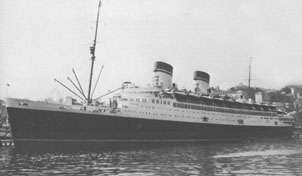SS Conte di Savoia
 SS Conte di Savoia lying at anchor at Genoa | |
| History | |
|---|---|
| Name: | SS Conte di Savoia |
| Owner: | Italian Line |
| Port of registry: |
|
| Builder: | Cantieri Riuniti dell'Adriatico of Trieste, Italy |
| Launched: | 18 October 1931 |
| Christened: | Marie José of Belgium |
| Maiden voyage: | 30 November 1932 |
| Fate: | Scuttled by retreating German military in September 1943 and scrapped in 1945. |
| General characteristics | |
| Type: | Ocean liner |
| Tonnage: | 48,502 gross tons |
| Length: | 248.25 m (814.5 feet) |
| Beam: | 29.28 m (96 feet) |
| Height: | 35 m (114.8 feet) |
| Draught: | 9.5 m (31.2 feet) |
| Installed power: | Steam turbines |
| Propulsion: | Quadruple propellers |
| Speed: | 27 knots (50 km/h) |
| Capacity: |
|
| Crew: | 786 total |
SS Conte di Savoia ("Count of Savoy") was an Italian ocean liner built in 1932 at the Cantieri Riuniti dell'Adriatico, Trieste.
Conte di Savoia was originally ordered for the Lloyd Sabaudo line, however, after a merger with the Navigazione Generale Italiana, the ship was completed for the newly formed Italia Flotte Riunite. The new Italia Line also controlled Rex, a similar though slightly larger ship completed just two months before Conte di Savoia. The Conte di Savoia was more modern in decoration and appearance than Rex and was the first liner fitted with gyroscopic stabilisers.
History
In November 1932 she made her maiden voyage to New York. The voyage almost became a disaster when an outlet valve jammed and blew a large hole below the waterline. The ship completed her maiden voyage thanks to crew member Gennaro Amatruda who plugged a leak in a broken valve port saving the ship from possible disaster. Conte di Savoia never held the Blue Riband for fastest speed during an Atlantic crossing, although on one attempt she did average just 0.2 knots (0.4 km/h) slower than the Blue Riband holder Rex.
Conte di Savoia had one unusual feature designed to increase passenger numbers. Three huge anti-rolling gyroscopes were fitted low down in a forward hold. These rotated at high revolutions and were designed to eliminate rolling - a persistent problem on the rough North Atlantic crossing that affected all shipping lines.[1] In practice they reduced the rolling by slowing down the rolling period, however, they also caused the vessel to "hang" annoyingly when the vessel was on the extreme limit of her rolls. For safety reasons the system was quickly abandoned on eastbound crossings where the prevailing weather produced following seas, although it was still used on westbound crossings. This was because with a following sea (and the deep slow rolls this generated) the vessel tended to 'hang' with the system turned on, and the inertia it generated made it harder for the vessel to right herself from heavy rolls.[1] None of this ever affected the operation of the shipping lines advertising department and the benefits of a "smooth crossing" were heavily promoted during the life of the ship.
During troop service in World War II, Conte di Savoia was set on fire and sunk by retreating German forces on 11 September 1943. She was raised in 1945, but eventually scrapped.
See also
References
- 1 2 "Italian Liner To Defy The Waves" Popular Mechanics, April 1931
External links
- Page at 20th Century Liners website
- History
- Statistics
- Winchester, Clarence, ed. (1937), "The Rex and the Conte di Savoia", Shipping Wonders of the World, pp. 1341–1345, illustrated description of the Rex and the Conte di Savoia